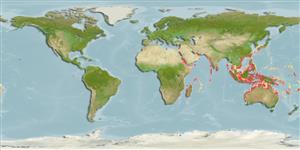| Native range | All suitable habitat | Point map | Year 2100 |

|
| This map was computer-generated and has not yet been reviewed. |
| Leiognathus berbis AquaMaps Data sources: GBIF OBIS |
Issue
Equula berbis is considered as a nomen dubium of uncertain placement beyond the family level (Ref. 84470:20-21). Correct name Equulites oblongus; the types are in poor condition and placement in the genus Equulites is provisional (P. Chakrabarty pers.comm. tru S. Bogorodsky, 11/2010).
Human uses
Fisheries: minor commercial
Phylogenetic diversity index
(Ref. 82805)
PD50 = 0.5039 many relatives (e.g. carps) 0.5 - 2.0 few relatives (e.g. lungfishes)
Trophic Level
(Ref. 69278)
3.3 ±0.41 se; Based on food items.
Resilience
(Ref. 69278)
High, minimum population doubling time less than 15 months (Preliminary K or Fecundity.)